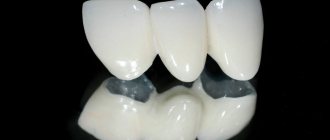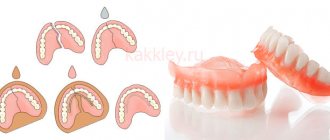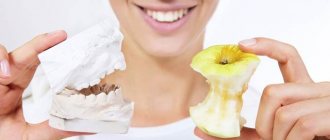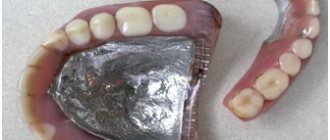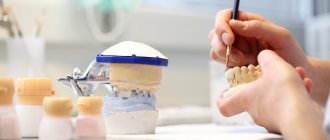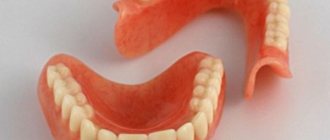What it is
Relining is the correction of an insert structure to improve the fit of the prosthesis to the gum and restore chewing functions. In addition, the rebased design should ensure the correct bite of the teeth when closing and opening the jaws.
If you neglect this procedure, you can get the following complications:
- breakage of the prosthesis;
- deformation and loss of supporting teeth;
- inflammation of the soft tissues of the oral cavity.
general information
Relining is a dental operation that is performed when the prosthetic bed does not match the prosthetic base for a number of reasons. It consists of replacing the acrylic supporting lining of the prosthesis adjacent to the gum.
The new onlay must fully correspond to the position of the hard tissues of the jaw and have a base adapted to chewing pressure. In addition, the relined prosthesis must ensure normal occlusion of all teeth and not cause disruption.
Failure to promptly contact a specialist for help can result not only in the failure of the prosthesis, but also in damage to the supporting teeth or their complete loss.
In this regard, during the first installation of a prosthesis in the oral cavity, the specialist recommends that the patient contact the dentist’s office at least once every six months. This approach allows you to promptly identify all possible violations and eliminate them without harm to the supporting teeth.
Indications for the procedure
Those who wear removable dentures need to visit a doctor once every six months for consultation and necessary relining. The procedure is necessary in the following cases:
- visible defects on the prosthesis;
- change in gum relief due to prolonged wear;
- unreliable fixation of the removable structure;
- transformation of the lower part of the face (height).
You cannot reline a prosthesis if it has significant defects and damage: in this case, a replacement is required. In case of inflammatory diseases of the oral cavity, relining is carried out only in laboratory conditions, but with the possibility of making impressions.
If the patient has an allergic reaction to plastic, a special laboratory will also be needed to reline the dentures.
Reviews
Removable orthopedic dental structures have bases made of metal or plastic. The doctor will always advise his patient the most optimal model for his case.
If you have already worn a prosthesis with a combined, metal or plastic base, share your impressions with our readers.
Perhaps it is your real assessment of the pros and cons of such products that will help many people make the right choice of device model at the stages of prosthetics for toothless jaws. You can leave your feedback in the “comments” section.
If you find an error, please select a piece of text and press Ctrl+Enter.
Tags: removable dentures
Did you like the article? stay tuned
No comments yet
Clinical method
The procedure for changing a device can be carried out in various ways. If the defects are minor, relining can be done directly in the dentist's office. It will take only 30 minutes to restore the damaged base.
Procedure steps:
- The doctor examines the oral cavity and evaluates the bite and position of the prosthesis, determines the places where the product presses on the gums.
- Evaluates the conformity of the bone relief and the adjacent structure.
- Starts working with the drill. The carborundum head gradually cuts off a layer of polymer no more than 1 mm from the inside of the base.
- The teeth and mucous surface of the mouth are treated with Vaseline, which prevents the adhesion of the liquid polymer.
- Then the specialist prepares a solution and applies it to the surface of the prosthesis.
- After 10 minutes, the prepared denture is put into place, and the patient closes and opens his teeth. The doctor models the edges of the product.
- After removing the structure, it is placed in hot water for some time, where it hardens and polymerizes.
- The specialist again begins fitting and adjusting the prosthesis so that the edges are in tight and comfortable contact with the gums.
- Finally, excess material is removed and the artificial teeth are polished.
This method is convenient because relining can be completed within one to two hours during one visit to the doctor.
Clinical method
The following factors can be considered as disadvantages:
- The liquid polymer has a toxic effect on the oral mucosa;
- The materials used in the work are of low quality, unlike those used in laboratory conditions;
- Such a prosthesis may not be strong enough due to air bubbles trapped under it.
However, many people prefer this relocation method.
Why is denture relining necessary?
As noted by K. Dorten, a professor at the University of Michigan School of Dentistry, fixation of a removable prosthetic structure is an important aspect of the dentition restoration procedure. Referring to his own research and practical experience, the specialist claims that the duration of the adaptation period largely depends on the quality of fixation. If the product does not stay in the mouth well enough, you should contact a specialist as soon as possible for correction.
Thus, relining or adjusting a removable denture is necessary in the following situations:
- discomfort after installation: if, after fixation, the structure causes certain inconvenience to the patient, the prosthesis rubs or interferes during conversation, then it requires relining,
- errors made during prosthetics, for example, at the stage of taking impressions or forming a plaster model. In some cases, the low quality of fixation of an orthopedic structure may be due to inaccuracies in the basic model on the basis of which the prosthesis itself is made. In such situations, adjustments may not be enough - you will have to redo the design again,
- poor fixation, which occurs due to atrophy of the jaw bone and subsidence of bone tissue. Naturally, the bone and gums sag unevenly, so bumps form somewhere on the mucous membrane, and somewhere, on the contrary, indentations. Such an uneven edge leads to the fact that the prosthesis does not fit tightly and the structure becomes mobile,
Poor fixation of the prosthesis
Important! Removable dentures cannot stop bone tissue atrophy, so the optimal solution to the problem is implantation. The method allows you to restore the tooth along with the root, which means the bone tissue will receive the usual load - its functioning will be restored.
- natural stretching of the structure: in this case, the possibility of relining the prosthesis directly depends on the material from which it is made. However, in a number of situations it is no longer possible to correct this state of affairs (for example, in the presence of nylon prostheses). Therefore, the only option to solve the problem is to use additional means of fixation.
Denture relining may also be required after dental implantation, which is carried out using a one-stage protocol. The structure is immediately installed on implants that are yet to undergo the engraftment stage. During this period, bone tissue regeneration occurs, that is, its restoration. As a result, the patient’s bite changes, and therefore after some time the prosthesis requires adjustment of its shape. The procedure is carried out in one visit directly in the orthopedist’s office, that is, in front of the patient.
Laboratory method
Work in the laboratory is carried out in cases where the prosthesis is manufactured for the first time and in cases of serious violations committed during manufacturing. And also with reduced bite heights. In this case, harmful toxins do not affect the mucous membranes of the mouth, and the product looks more aesthetically pleasing than with the clinical method.
Relocation stages:
- The prosthesis is removed and sent to the laboratory, where the top layer of plastic is removed.
- New dental impressions are taken from the patient.
- The old denture and the new impression are placed in a mold into which the plaster mixture is poured.
- The impression is then removed and the space is filled with a polymer material that bonds to the item.
- At high temperatures, the applied material polymerizes.
- The finished structure is removed, cleaned of excess and polished.
- The prosthesis is tried on the patient. If necessary, the bridge is adjusted again.
- If a person does not experience discomfort during installation, chews easily, closes his jaws, the relining is completed.
Relining is carried out using hot polymerization plastic
The big disadvantage of this method is the length of the wait and the need to visit the doctor several times. Production time takes from two to five days.
Which prostheses require correction?
The main goal of this procedure is to improve the density of contact between the device and the tissues of the oral cavity, as well as to restore the physiologically correct closure of the jaws. Thus, relining allows for rational distribution of pressure on the mucous membrane.
Relining is carried out with removable structures, as well as conditionally removable ones, which are fixed on implants (mostly we are talking about immediate loading protocols, when the structure is placed immediately after implantation). All other prostheses are securely fixed and there is no need to adjust them.
conditionally removable dentures
Reduced bite height
This is a case that has its own characteristics, since during atrophic processes the indicator of the central ratio of occlusion changes. To take the necessary measurements, it is necessary to place a small layer of thermoplastic resin between the teeth to reline the dentures in the mouth.
After this, the specialist must measure the height of the lower third of the face with the jaws closed and at rest. In this way, it is possible to achieve the most comfortable interocclusal gap, at which the patient will feel comfortable chewing food and closing the teeth normally.
For such indications, relocation is performed only in the laboratory and takes several days. The cost of this procedure is more expensive than usual.
When does mobility of a denture appear?
A removable denture must fit snugly to the oral mucosa, hold well, and not wobble or balance.
Under such conditions, the prosthesis perfectly performs its functions: chewing food, biting food, diction, communication and articulation, supporting the soft tissues of the face: lips and cheeks. Mobility of the prosthesis can occur for various reasons. Most often this is a long service life, more than 3-5 years. During this time, a natural change in the shape of the mucous membrane of the prosthetic bed occurs, that is, a change in the shape of the gums under the prosthesis. During this time, the plastic wears out, the gums shrink, it is difficult to chew food with such dentures, and the dentures darken. This is a feature of removable dentures. In such a situation, we recommend that you seek an examination to decide on the stabilization of the prosthesis.
If the denture is well preserved, the relief of the teeth is not changed, the denture is less than 5 years old and was made in our clinic, we suggest relining the denture. When relining, a layer of plastic is added to the thickness of the atrophied (reduced) gum. After this, the prosthesis holds well again.
As an example, we give the case of larger shoes. When the shoes fit well on the foot, they are comfortable to walk and run in - they don’t pinch, don’t press, don’t rub. Also with a new denture. However, after some time, part of the gum may atrophy (shrink) under the prosthesis, which leads to the fact that the prosthesis becomes too large. The denture does not fit tightly on the gum. It is the movements of such a prosthesis that lead to the following consequences:
- Rubbing gums
- Cheek biting
- Danger of the prosthesis falling off during sleep,
- Impaired diction,
- Impaired chewing of food
- Decreased self-confidence, the prosthesis may fail,
- Constant discomfort and adjustment of the prosthesis,
- The prosthesis should be monitored throughout the day.
If such a situation arises, we recommend making an appointment by calling: 7 (343) 2-682-482.
With repeated prosthetics and when severe atrophy of the alveolar crest of the jaw has occurred (the gum has decreased), then it is necessary to make a new prosthesis taking into account the individual characteristics of the future prosthetic bed.
New dentures that have just been properly made do not loosen and should be fixed in place on their own, without special creams. As they say, put it on and go. There should be a feeling that the denture has become native, your own.
A complete removable denture dangles on any jaw
Slight mobility of the partial removable denture is allowed. Although this is extremely rare and depends on the number of supporting teeth that the prosthesis holds. In this case, when the hooks are loosened, the clasps are tightened and pressed more tightly to the tooth. Important! Activation (pulling) of the hook should only be performed by a specialist. If you do this work yourself at home, there is a significant risk of breaking the hook.
Slight mobility of a complete removable denture on any jaw is allowed. After all, the prosthesis, lying on the mucous membrane, has micro mobility. Each person has a different thickness of the mucous membrane in the oral cavity. For those who have thin gums, micromobility is unnoticeable, unless, of course, you specifically concentrate your attention on it.
Contraindications
Relining a removable denture is not done if:
- damage to the structure occurred due to a strong impact on a hard object or other mechanical impact that violated the integrity of the system;
- the prosthesis no longer meets the standards necessary for its continued wearing due to loss of integrity;
- there are one or more broken elements;
- anatomical retention is impaired, in which the prosthetic bed is not able to hold the prosthesis;
- The structure is unstable and can fall apart into its component parts at any moment.
The above reasons indicate the futility of relining a removable denture, since urgent production of a new system is required.


